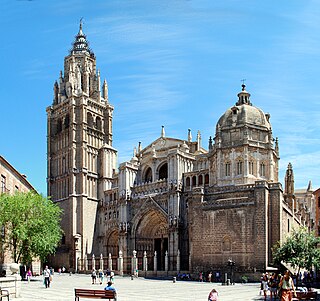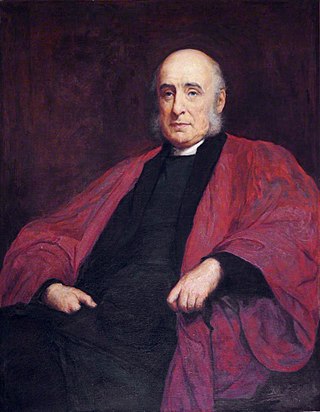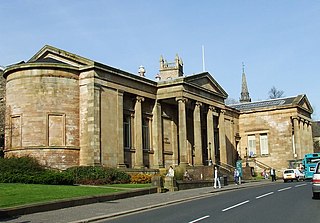Related Research Articles

The Roman Missal is the title of several missals used in the celebration of the Roman Rite. Along with other liturgical books of the Roman Rite, the Roman Missal contains the texts and rubrics for the celebration of the most common liturgy and Mass of the Catholic Church.

The Tridentine Mass, also known as the Traditional Latin Mass or the Traditional Rite, is the liturgy in the Roman Missal of the Catholic Church published from 1570 to 1962. Celebrated almost exclusively in Ecclesiastical Latin, it was the most widely used Eucharistic liturgy in the world from its issuance in 1570 until the introduction of the Mass of Paul VI.

Burntisland is a former royal burgh and parish in Fife, Scotland, on the northern shore of the Firth of Forth. According to the 2011 census, the town has a population of 6,269. It was previously known as Wester Kinghorn or Little Kinghorn.

The Mozarabic Rite, officially called the Hispanic Rite, and in the past also called the Visigothic Rite, is a liturgical rite of the Latin Church once used generally in the Iberian Peninsula (Hispania), in what is now Spain and Portugal. While the liturgy is often called 'Mozarabic' after the Christian communities that lived under Muslim rulers in Al-Andalus that preserved its use, the rite itself developed before and during the Visigothic period. After experiencing a period of decline during the Reconquista, when it was superseded by the Roman Rite in the Christian states of Iberia as part of a wider programme of liturgical standardization within the Catholic Church, efforts were taken in the 16th century to revive the rite and ensure its continued presence in the city of Toledo, where it is still celebrated today. It is also celebrated on a more widespread basis throughout Spain and, by special dispensation, in other countries, though only on special occasions.

A missal is a liturgical book containing instructions and texts necessary for the celebration of Mass throughout the liturgical year. Versions differ across liturgical tradition, period, and purpose, with some missals intended to enable a priest to celebrate Mass publicly and others for private and lay use. The texts of the most common Eucharistic liturgy in the world, the Catholic Church's Mass of Paul VI of the Roman Rite, are contained in the 1970 edition of the Roman Missal. Missals have also been published for earlier forms of the Roman Rite and other Latin liturgical rites. Other liturgical books typically contain the Eucharistic liturgies of other ritual traditions, but missals exist for the Byzantine Rites, Eastern Orthodox Western Rites, and Anglican liturgies.

The Confiteor is one of the prayers that can be said during the Penitential Act at the beginning of Mass of the Roman Rite in the Catholic Church. It is also said in the Lutheran Church at the beginning of the Divine Service, and by some Anglo-catholic Anglicans before Mass.

An antiphonary or antiphonal is one of the liturgical books intended for use in choro, and originally characterized, as its name implies, by the assignment to it principally of the antiphons used in various parts of the Latin liturgical rites.
William Scheves was the second Archbishop of St. Andrews. His parentage is obscure, but he was probably the illegitimate son of a royal clerk, John Scheves. Sixteenth-century accounts claim he spent several years abroad and studied at the University of Louvain. He spent several years at the University of St Andrews as an administrator. In his earlier ecclesiastical career, he had been clericus regiae and master of the hospital of Brechin. In 1474 he was provided unsuccessfully to the Archdeaconry of Dunblane, but by the beginning of 1477 he was Archdeacon of St Andrews and coadjutor (successor) and vicar-general of the archdiocese. After the deposition of Archbishop Patrick Graham in 1478, he succeeded to the archbishopric, apparently receiving the papal pall while in the presence of King James III and many of the nobility at Holyrood.
There have been five Baronetcies created for people with the surname Forbes, four in the Baronetage of Nova Scotia and one in the Baronetage of the United Kingdom. The first holder of the Burn Baronetcy of Jessfield, created in the Baronetage of the United Kingdom in 1923, assumed the surname of Forbes-Leith of Fyvie in 1925.
The Collect for Purity is the name traditionally given to the collect prayed near the beginning of the Eucharist in most Anglican rites. Its oldest known sources are Continental, where it appears in Latin in the 10th century Sacramentarium Fuldense Saeculi X.

New Pitsligo, also known as Cavoch, is a village in Aberdeenshire, Scotland, quite near Fraserburgh.
Laurence is the first Bishop of Dunblane to be known by name. A document dating to 27 February 1155, had an M. de Dunblan, but no more is known of this man and it is unlikely that M. is a mistake for La..
Simon is the third known 12th century Bishop of Dunblane. Nothing is known of Simon's background as there are numerous Simons in Scotland in this period, both native and foreign. There is a Symon de Liberatione who witnessed a charter of King William the Lion and whom Watt and Murray suggested may have been the later Bishop of Dunblane, while there was in the same decade a local landholder and ecclesiastical patron in the diocese of Dunblane called Simón son of Mac Bethad.

William George Henderson was Dean of Carlisle from 1884 to his death in 1905.
The embolism in Christian liturgy is a short prayer said or sung after the Lord's Prayer. It functions "like a marginal gloss" upon the final petition of the Lord's Prayer, amplifying and elaborating on "the many implications" of that prayer. According to the 1913 Catholic Encyclopedia, "[t]he embolism may date back to the first centuries, since, under various forms, it is found in all the Occidental and in a great many Oriental, particularly Syrian, Liturgies."
Martin Morin was a French printer of incunables, active in Rouen between about 1490 and 1518. It has been suggested that he was born in or near Orbec around 1450, and died in Rouen around 1522. He learned the trade in the Rhine region where he was sent by the Rouen family Lallemant together with Pierre Maufer, and then became a printer and bookseller in Rouen. His 1492 Breviarium Saresberiense or Breviarium Sarum, a breviary for Salisbury, is said to be "the first recorded liturgical book printed for the English market".
The Pitsligo Press was a printing press founded in 1852 by Scottish Episcopal priest and scholar George Hay Forbes (1821–1875) in Burntisland, Scotland. It published sermons, periodicals, patristic texts, liturgical material, and used fonts in Latin types, as well as Greek, Hebrew, Aramaic, Syriac, Ethiopic and Armenian.

Paisley Museum and Art Galleries is currently closed for refurbishment and is due to reopen 2024. It is a museum and public art gallery located in the town of Paisley and is run by Renfrewshire Council. It houses one of the largest municipal art collections in Scotland, including over 800 paintings.

Sicut cervus is a motet for four voices by Giovanni Pierluigi da Palestrina. It sets the beginning of Psalm 42, Psalmus XLII in the Latin version of the Psalterium Romanum rather than the Vulgate Bible. The incipit is "Sicut cervus desiderat ad fontes" followed by a second part "Sitivit anima mea". It was published in 1604 in Motecta festorum, Liber 2, and has become one of Palestrina's most popular motets, regarded as a model of Renaissance polyphony, expressing spiritual yearning.

The twenty-two volumes of the Historiæ Patriæ Monumenta series contain Italian historical documents and were published between 1836 and 1901 in two series.
References
- ↑ Hidden treasures revealed to the nation
- 1 2 Catholic Encyclopedia. "Missal of Arbuthnott" . Retrieved 28 April 2007.
- ↑ "Renfrewshire Community Website - Arbuthnott Manuscripts". Archived from the original on 21 September 2007. Retrieved 12 October 2007.